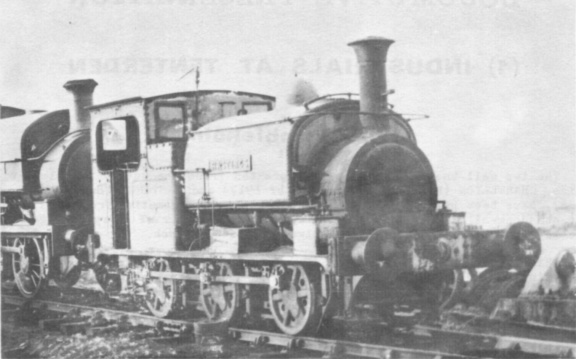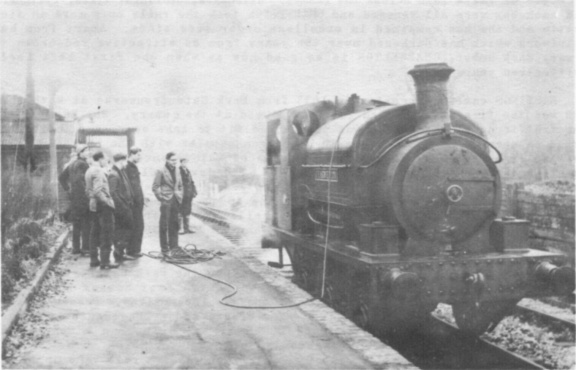
| THE INDUSTRIAL RAILWAY RECORD |
© DECEMBER 1964 |
LOCOMOTIVE PRESERVATION
(1) INDUSTRIALS AT TENTERDEN
BY
R. CrombleholmeThe two well-known locomotives at Sproxton Ironstone Quarry in Leicestershire, CHARWELTON (Manning Wardle 1955 of 1917) and HASTINGS (Hunslet 469 of 1888), have been purchased by the Kent & East Sussex Locomotive Trust, following the abandonment of the quarry‘s railway system in favour of lorry haulage from the working faces to the British Railways Sproxton branch.
CHARWELTON arrived at Sproxton from Charwelton Quarries in March 1942 and, according to the Sproxton foreman, she was in a very sorry state. The cylinders were completely worn through and the pistons visible, while the smokebox had rusted so badly that the chimney had collapsed down on to the blastpipe. She was painstakingly rebuilt by the Sproxton staff who, undaunted by the lack of lifting tackle, raised CHARWELTON with jacks on a "birdcage" of sleepers until her chimney just touched the shed roof; all three pairs of wheels were then slid out. The boiler was removed by more jacking and rolled out sideways on a couple of rails laid across the frames. Axieboxes, bearings, tyres, cylinders and smokebox were all renewed and CHARWELTON took the rails once more in fine fettle and she has remained in excellent order ever since. Apart from her paintwork which has darkened over the years from an attractive red-brown to a very dark umber, CHARWELTON is as good now as when she first left Leeds forty-seven years ago.
HASTINGS came to Sproxton in 1935 from Park Gate Ironworks at Rotherham and was the first six-coupled locomotive used at the quarry. She handled all the traffic until CHARWELTON was pronounced fit to take over, and thereafter acted as spare. HASTINGS seems to have been popular with the Sproxton crews because of her economical running and ease of maintenance compared with the later engines. With the arrival in 1957 of Hudswell Clarke 1630 of 1929, HASTINGS became third engine and for three years languished unwanted at the end of a siding, her brown paintwork fading to what can only be described as "shocking" pink. CHARWELTON proved so reliable in service that even the Hudswell hardly ever had to be steamed, and as HASTINGS needed a partial retubing she became just a static exhibit.
When rail haulage ceased on 18 October 1963, the Park Gate Iron & Steel Co. Ltd. was approached by the newly-formed Kent & East Sussex Locomotive Trust with a view to the preservation of the two locomotives. Prices of £280 for CHARWELTON and £250 for HASTINGS were agreed and arrangements were made to take them down by road to Tenterden. Hallett, Silberman & Company of Watford sent one of their low-loaders to collect CHARWELTON on New Year‘s Eve, 1963, and with the ready aid of the Sproxton staff a rail ramp up to the lorry from the truncated siding where the two engines were huddled was built, In spite of a derailment whilst being hauled up the ramp by the quarry grader CHARWELTON and a host of spares were finally loaded by 5.30 p.m. and the lorry trundled out of the gate and headed for the Great North Road and Tenterden.


Upper – HASTINGS and CHARWELTON awaiting removal from Sproxton on 31 December.
Lower – Amidst a crowd of admirers, CHARWELTON takes water from a hosepipe at Tenterden Town station on the occasion of her first steaming, 5 January.
HASTINGS was collected the following day and both engines arrived at Tenterden on Thursday, 2 January 1964 exactly ten years to the day after the Kent & East Sussex Railway passenger service ceased. Before the cameras of enthusiasts and local pressmen. CILARWELTON rolled on to the metals at her new home the same afternoon, the first Manning Wardle at Tenterden for over a quarter of a century.
HASTINGS was unloaded the following day and almost derailed herself in the process. At the weekend crowds turned up at Tenterden and, dead on the stroke of one by the Church clocks CHARWELTON moved under her own steam on K. & E.S.R. metals for the first time. The afternoon was spent in shunting within station limits and transferring HASTINGS and the Trust‘s three other locomotives – GERVASE (Manning Wardle 1472 of 1900), DOM (Sentinel 6994 of 1927) and MARCIA (Peckett 1631 of 1923) – to a long siding behind the platform. HASTINGS has, so to speak, returned to her former haunts, for she was originally the property of T.A. Walker who used her on a contract in the vicinity, The Mayor of Hastings is to be invited to "unveil" her when restoration work is complete,
It is hoped that a passenger service will be restored on the K. & E.S.R. in 1965, and if this takes effect both the Sproxton engines will be fitted with the vacuum brake and take their turn on passenger duties. Although the bulk of the money to meet their purchase price has still to be raised, the Kent & East Sussex Locomotive Trust has given HASTINGS and CHARWELT0N a new and exciting lease of life and cheated the scrapmen of two more victims.
FAIR COMMENT ?
"Dear Sirs,
Have received the almanac you have sent us. If you tried your best you could not have shown an uglier engine. It must have been designed by some wheelwright, not an engineer. It‘s uglier than the Leeds engines, and that‘s saying a good deal."
FAIR DEAL?
"Dear Sirs,
Referring to the Loco No. 1209 received from you yesterday, we are asking our London House to send you a Contract Note for 11¼ tons of Copper at the price of £74 per ton to be taken in payment for the loco."
(Two letters received by Peckett & Sons, Bristol., The former was written by a certain Lancashire firm on 18th January 1899, and the latter by Nevill, Druce & Co., Llanelly, on 10th February 1910. – K.P.P.)